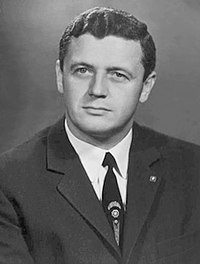Vladislav Volkov
Russian - (RFSA)
Lost In Flight
Date of Birth: Nov. 23, 1935
Date of Death: June 30, 1971
Vladislav Nikolayevich Volkov (Russian: Владисла́в Никола́евич Во́лков; November 23, 1935 – June 30, 1971) was a Soviet cosmonaut who flew on the Soyuz 7 and Soyuz 11 missions. The second mission terminated fatally. Volkov, on his second space mission in 1971, was assigned to Soyuz 11. The three cosmonauts on this flight spent 23 days on Salyut 1, the world's first space station. After three relatively placid weeks in orbit, however, Soyuz 11 became the second Soviet space flight to terminate fatally, after Soyuz 1. After a normal re-entry, the Soyuz 11 capsule was opened and the corpses of the three crew members were found inside. It was discovered that a valve had opened just prior to leaving orbit that had allowed the capsule's atmosphere to vent away into space, causing Volkov and his two flight companions to suffer fatal hypoxia as their cabin descended toward the earth's atmosphere.
Soyuz | Soyuz 7
Russian Federal Space Agency (ROSCOSMOS) | RussiaBaikonur Cosmodrome, Republic of Kazakhstan
Oct. 12, 1969, 10:44 a.m.
Status: Success
Mission:
Soyuz 7 was a joint mission with Soyuz 6 and Soyuz 8 that saw three spacecraft in orbit together at the same time. The mission was to dock with Soyuz 8 and transfer crew. Docking to Soyuz 8 failed so the mission was aborted. The mission was Commanded by Anatoly Filipchenko, Flight Engineer Vladislav Volkov, and Research Engineer Viktor Gorbatko.
Low Earth OrbitSoyuz | Soyuz 11
Russian Federal Space Agency (ROSCOSMOS) | RussiaBaikonur Cosmodrome, Republic of Kazakhstan
June 6, 1971, 4:55 a.m.
Status: Success
Mission:
Soyuz 11 launched on 6 June 1971, 07:55:09 UTC. It carried commander Georgy Dobrovolsky, flight engineer Vladislav Volkov and test engineer Viktor Patsayev to orit. Crew arrived to Salyut-1 space station on 7 June 1971 and remained there until their departure on 30 June. It was the only mission to board the space station. Soyuz 11 returned to Earth on 30 June 1971, 02:16:52 UTC, with mission ending in disaster. During atmospheric re-entry crew capsule depressurised, killing all three crew members.
Low Earth OrbitThe Roscosmos State Corporation for Space Activities, commonly known as Roscosmos, is the governmental body responsible for the space science program of the Russian Federation and general aerospace research. Soyuz has many launch locations the Russian sites are Baikonur, Plesetsk and Vostochny however Ariane also purchases the vehicle and launches it from French Guiana.
Ariane 62
Galileo L14 (FOC FM33 & FM34)
Ariane Launch Area 4 - Guiana Space Centre, French GuianaPayload consists of two satellites for Europe's Galileo navigation system.
Atlas V 551
Amazon Leo (LA-04)
Space Launch Complex 41 - Cape Canaveral SFS, FL, USAAmazon Leo, formerly known as Project Kuiper, is a mega constellation of satellites in Low Earth Orbit that will offer broadband internet access, thi…
Long March 4B
Ziyuan-3-04
Launch Complex 9 - Taiyuan Satellite Launch Center, People's Republic of ChinaThe ZY-3 (Ziyuan-3, 'Resource-3') series represents China's first high-resolution, stereoscopic mapping satellites for civilian use. The second sa…
Falcon 9
Starlink Group 6-82
Space Launch Complex 40 - Cape Canaveral SFS, FL, USAA batch of 29 satellites for the Starlink mega-constellation - SpaceX's project for space-based Internet communication system.
Falcon 9
Starlink Group 15-12
Space Launch Complex 4E - Vandenberg SFB, CA, USAA batch of 27 satellites for the Starlink mega-constellation - SpaceX's project for space-based Internet communication system.


